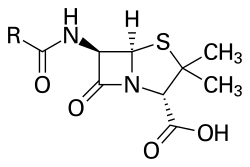Beta-lactam

A beta-lactam (β-lactam) ring is a four-membered lactam.[1] (A lactam is a cyclic amide.) It is named as such because the nitrogen atom is attached to the β-carbon atom relative to the carbonyl. The simplest β-lactam possible is 2-azetidinone.
Clinical significance

The β-lactam ring is part of the core structure of several antibiotic families, the principal ones being the penicillins, cephalosporins, carbapenems, and monobactams, which are, therefore, also called β-lactam antibiotics. Nearly all of these antibiotics work by inhibiting bacterial cell wall biosynthesis. This has a lethal effect on bacteria, although any given bacteria population will typically contain a subgroup that is resistant to β-lactam antibiotics. Bacterial resistance occurs as a result of the expression of one of many genes for the production of β-lactamases, a class of enzymes that break open the β-lactam ring. More than 1,800 different β-lactamase enzymes have been documented in various species of bacteria.[2] These enzymes vary widely in their chemical structure and catalytic efficiencies.[3] When bacterial populations have these resistant subgroups, treatment with β-lactam can result in the resistant strain becoming more prevalent and therefore more virulent. β-lactam derived antibiotics can be considered as one of the most important antibiotic classes but prone to clinical resistance. β-lactam exhibits its antibiotic properties by imitating the naturally occurring d-Ala-d-Ala substrate for the group of enzymes known as penicillin-binding proteins (PBP), which have as function to cross-link the peptidoglycan part of the cell wall of the bacteria.[4]
History
The first synthetic β-lactam was prepared by Hermann Staudinger in 1907 by reaction of the Schiff base of aniline and benzaldehyde with diphenylketene[5][6] in a [2+2] cycloaddition (Ph indicates a phenyl functional group):
Up to 1970, most β-lactam research was concerned with the penicillin and cephalosporin groups, but since then, a wide variety of structures have been described.[7]
Synthesis
The Breckpot synthesis
- The synthesis of substituted β-lactams from the cyclization of beta amino acid esters using the Grignard reagent

Reactivity
Due to ring strain, β-lactams are more readily hydrolyzed than linear amides or larger lactams. This strain is further increased by fusion to a second ring, as found in most β-lactam antibiotics. This trend is due to the amide character of the β-lactam being reduced by the aplanarity of the system. The nitrogen atom of an ideal amide is sp2-hybridized due to resonance, and sp2-hybridized atoms have trigonal planar bond geometry. As a pyramidal bond geometry is forced upon the nitrogen atom by the ring strain, the resonance of the amide bond is reduced, and the carbonyl becomes more ketone-like. Nobel laureate Robert Burns Woodward described a parameter h as a measure of the height of the trigonal pyramid defined by the nitrogen (as the apex) and its three adjacent atoms. h corresponds to the strength of the β-lactam bond with lower numbers (more planar; more like ideal amides) being stronger and less reactive.[8] Monobactams have h values between 0.05 and 0.10 angstroms (Å). Cephems have h values in of 0.20–0.25 Å. Penams have values in the range 0.40–0.50 Å, while carbapenems and clavams have values of 0.50–0.60 Å, being the most reactive of the β-lactams toward hydrolysis.[9]
Other applications
A new study has suggested that β-lactams can undergo ring-opening polymerization to form amide bonds, to become nylon-3 polymers. The backbones of these polymers are identical to peptides, which offer them biofunctionality. These nylon-3 polymers can either mimic host defense peptides or act as signals to stimulate 3T3 stem cell function.
Antiproliferative agents that target tubulin with β-lactams in their structure have also been reported.[10][11]
See also
References
- ↑ Gilchrist, T. (1987). Heterocyclic Chemistry. Harlow: Longman Scientific. ISBN 0-582-01421-2.
- ↑ Brandt, C.; et al. (2017). "In silico serine β-lactamases analysis reveals a huge potential resistome in environmental and pathogenic species". Scientific Reports. 7 (43232). Bibcode:2017NatSR...743232B. doi:10.1038/srep43232.
- ↑ Ehmann, David E.; et al. (2012). "Avibactam is a covalent, reversible, non-β-lactam β-lactamase inhibitor". PNAS. 109 (29): 11663–11668. Bibcode:2012PNAS..10911663E. doi:10.1073/pnas.1205073109. PMC 3406822.
- ↑ Tipper, D. J.; Strominger, J. L. Proc. Natl. Acad. Sci. U.S.A. 1965, 54, 1133– 41[Crossref], [PubMed], [CAS]
- ↑ Tidwell, Thomas T. (2008). "Hugo (Ugo) Schiff, Schiff Bases, and a Century of β-Lactam Synthesis". Angewandte Chemie International Edition. 47 (6): 1016–20. doi:10.1002/anie.200702965. PMID 18022986.
- ↑ Hermann Staudinger (1907). "Zur Kenntniss der Ketene. Diphenylketen". Justus Liebigs Ann. Chem. 356 (1–2): 51–123. doi:10.1002/jlac.19073560106.
- ↑ Flynn, E.H. (1972). Cephalosporins and Penicillins : Chemistry and Biology. New York and London: Academic Press.
- ↑ Woodward, R.B. (1980). "Penems and related substances". Phil. Trans. R. Soc. Lond. B. 289 (1036): 239–50. Bibcode:1980RSPTB.289..239W. doi:10.1098/rstb.1980.0042. PMID 6109320.
- ↑ Nangia, A.; Biradha, K.; Desiraju, G.R. (1996). "Correlation of biological activity in β-lactam antibiotics with Woodward and Cohen structural parameters: A Cambridge database study". J Chem Soc, Perkin Trans. 2 (5): 943–53. doi:10.1039/p29960000943.
- ↑ O'Boyle, Niamh; Miriam Carr; Lisa Greene; Orla Bergin; Seema M. Nathwani; Thomas McCabe; David G. Lloyd; Daniela M. Zisterer; Mary J. Meegan (December 2010). "Synthesis and Evaluation of Azetidinone Analogues of Combretastatin A-4 as Tubulin Targeting Agents". Journal of Medicinal Chemistry. 53 (24): 8569–8584. doi:10.1021/jm101115u. PMID 21080725.
- ↑ O'Boyle, Niamh; Lisa Greene; Orla Bergin; Jean-Baptiste Fichet; Thomas McCabe; David G. Lloyd; Daniela M Zisterer; Mary J. Meegan (2011). "Synthesis, evaluation and structural studies of antiproliferative tubulin-targeting azetidin-2-ones" (PDF). Bioorganic and Medicinal Chemistry. 19 (7): 2306–2625. doi:10.1016/j.bmc.2011.02.022. hdl:2262/54923.
